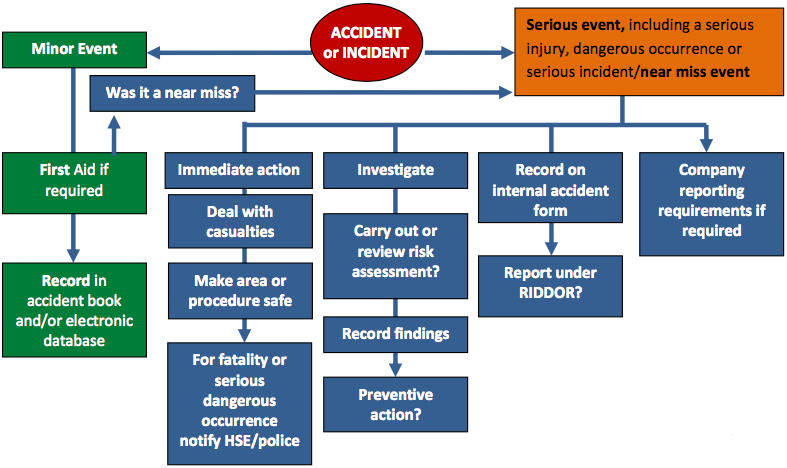
What is an Incident Report?
An incident report is a tool that documents any event that may or may not have caused injuries to a person or damage to a company asset. It captures injuries and accidents, near misses, property and equipment damage, health and safety issues, security breaches and misconduct in the work site.
What is the Purpose of Incident Reporting?
As part of Incident Management, incident reporting records an incident, determines its possible cause, documents any actions taken, and makes it known to stakeholders. An incident report can be used in the investigation and analysis of an event or as safety documents that indicate potential risks and uncontrolled hazards found on the work site for future assessments (e.g., ergonomic assessments).
An incident report is utilized by:
- an authority to create a report of an incident;
- a worker to report an incident he/ she has witnessed;
- any member of the organization to raise awareness about an incident that has occurred in the worksite.
Top 3 Benefits of Incident Reporting
The management and their workers should know why incident reporting can not only improve an organization’s safety but also help the business stand out from others and, most importantly, help create a sound and healthy working environment and culture for workers.
1. Immediate Reinforcement of Actions
If an incident happens at work, documenting and reporting the details to management can induce immediate and necessary measures to be taken (e.g., providing first aid). This also heightens the seriousness and gravity of any incident, reminding all workers that these events should be reported, whether big or small. Immediate action also helps leaders magnify their responsibilities in ensuring a safer place for their workers.
2. Communication on Hazards and Threats
Communicating threats, risks, and hazards to all concerned and affected workers in an organization helps raise awareness of possible dangers that may arise. This could be an essential tool for industries in which tasks are associated with the highest risks, such as the construction, manufacturing, mining industries, and even offices, which are prone to unexpected incidents because of potential hazards that can be overlooked.
3. Continuous Improvement of Processes
An incident report provides a clear picture of what an organization should focus on resolving, changing, improving, or eliminating. This also helps the management implement new policies to determine the efficacy of these changes for safety and quality.
What are the 4 Types of Incident Reports?
Here are 4 types of incidents you should report:
- Sentinel events – these are unexpected occurrences that result in serious physical or psychological injury or death (e.g., slips, trips and falls, natural disasters, vehicle incidents, disease outbreaks, etc.).
- Worker injury incident
- Environmental incident
- Property damage incident
- Vehicle incident
- Fire incident
- Near misses – these are situations where the people involved had no injuries but could have been potentially harmed by the risks detected.
- Adverse events – related to medicine, vaccines, and medical devices (in compliance with ISO 14971). These events occur when an act of commission or omission harms a patient rather than the existing disease or condition.
- No harm events – these are incidents that need to be communicated across an organization to raise awareness of any harm that may happen.
Additionally, there are two major ways to create a comprehensive incident report: list type and narrative type. List-type reporting allows users to enumerate all the relevant information in a straight-to-the-point approach. Narrative reporting, meanwhile, involves documenting events in a descriptive or storytelling manner. As the keyword suggests, it narrates the whole incident from start to finish.
What to Include in an Incident Report
To ensure effective incident reporting, it should be accurate, factual, complete, graphic, and valid. Here’s a list of elements that would guide you during the documentation of an incident:
- General information
- Setting or environment
- Affected people
- Injuries and the severity
- Witnesses
- Administered treatment
- Property and equipment damages
- Events
- Actions of people involved during the incident
Improve your GRC management
Simplify risk management and compliance with our centralized platform, designed to integrate and automate processes for optimal governance.
How to Write an Incident Report: A Step-by-Step Guide (with Examples)
Now that we have an idea of what information should be included in an incident report, here’s a sample walkthrough of an incident report PDF sample to give you a clearer picture of how you can create an effective incident report. Additionally, this walkthrough is performed using a digital incident report template.
Incident Report Template: Manufacturing Unit Accident Report
- Basic Information:
Date of Incident: _______
Time of Incident: _______
Location of Incident: ___
Reported By: ____________
Contact Information: ____
Job Title: ______________ - Persons Involved:
Name(s): ________________
Employee ID(s): _________
Department: _____________
Supervisor: _____________ - Description of Incident:
Brief Description: ________________________________________________________
Equipment Involved (if any): ______________________________________________
Witnesses (if any): ______________________________________________________
Injuries Sustained: ______________________________________________________
Immediate Actions Taken: _________________________________________________ - Cause of the Incident:
Root Cause Analysis: _____________________________________________________
Unsafe Conditions or Acts: ________________________________________________ - Corrective and Preventive Actions:
Actions Taken to Prevent Recurrence: ____________________________________
Responsible Person for Follow-Up: _____________________________________
Deadline for Implementation: _____________________________________ - Additional Information:
Photos Attached (Yes/No): __
Other Supporting Documents: __
Additional Remarks: ______________________________________________________ - Signatures:
Reported By: ____________
Supervisor: _____________
Safety Officer: __________
Date of Submission: _______
Step 1: Provide Fundamental Information
To make sure that no essential details are missed, collect the basic information and write them down. You can do this by answering the following questions:
- What type of injury was caused, if any? Was it fatal or non-fatal?
- Was there any property damage?
- When and where did it take place?
- What task was being done at the time when the incident occurred?
- What was the environment like?
Step 2: Take Note of Any Damages and Injuries
The next thing you would want to do is determine the results of the incident. Did it cause any damage or injure anyone? If so, you should describe it in detail and, if appropriate, provide photo evidence of the damage.
Step 3: Identify Affected Individual(s)
Provide the names of the people involved along with their job details, such as title, shift arrangement, and other relevant information.
Step 4: Identify Witnesses and Take Their Statements
Record the names of people present during the incident and gather their statements. These will be valuable in understanding the sequence of events that led to the incident and may even provide you with a better insight into whether or not the behaviour of the affected employees was a factor that contributed to the injury or damage. Witnesses’ statements can be noted verbatim or paraphrased. Remember to have the witnesses sign off on their statements to verify the accuracy of what has been recorded.
Step 5: Take Action
This refers to the actions that should be taken after the incident. It includes corrective actions that will eliminate the recurrence of the incident. The corrective actions section of your incident report can also include the actions that you need to take to complete the report.
Step 6: Close Your Report
Upon completion of the previous sections, you may collect management’s comments on the incident. For accountability measures, you, as the reporter, and someone from upper management should sign off. This will validate that the information stated in the incident report is truthful and unquestionable.
Effective Incident Reporting with SafetyCulture
Incident reports should be properly kept, as they are an important record of every organization. Creating incident reports can be time-consuming and requires rigorous documentation of the incident. SafetyCulture can be used to streamline the completion and record-keeping of incident reports.
Optimize your organization’s operations and workflow with SafetyCulture. Our digital platform enables you to:
- Simplify processes by automating manual and repetitive tasks
- Maintain safety, quality, and compliance standards with digital checklists
- Create powerful workflows by integrating your existing systems and software
- Gain greater visibility and transparency with real-time reporting
Take advantage of our comprehensive features to transform your organization’s capabilities towards operations excellence.
Financial and Business expert having 30+ Years of vast experience in running successful businesses and managing finance.





